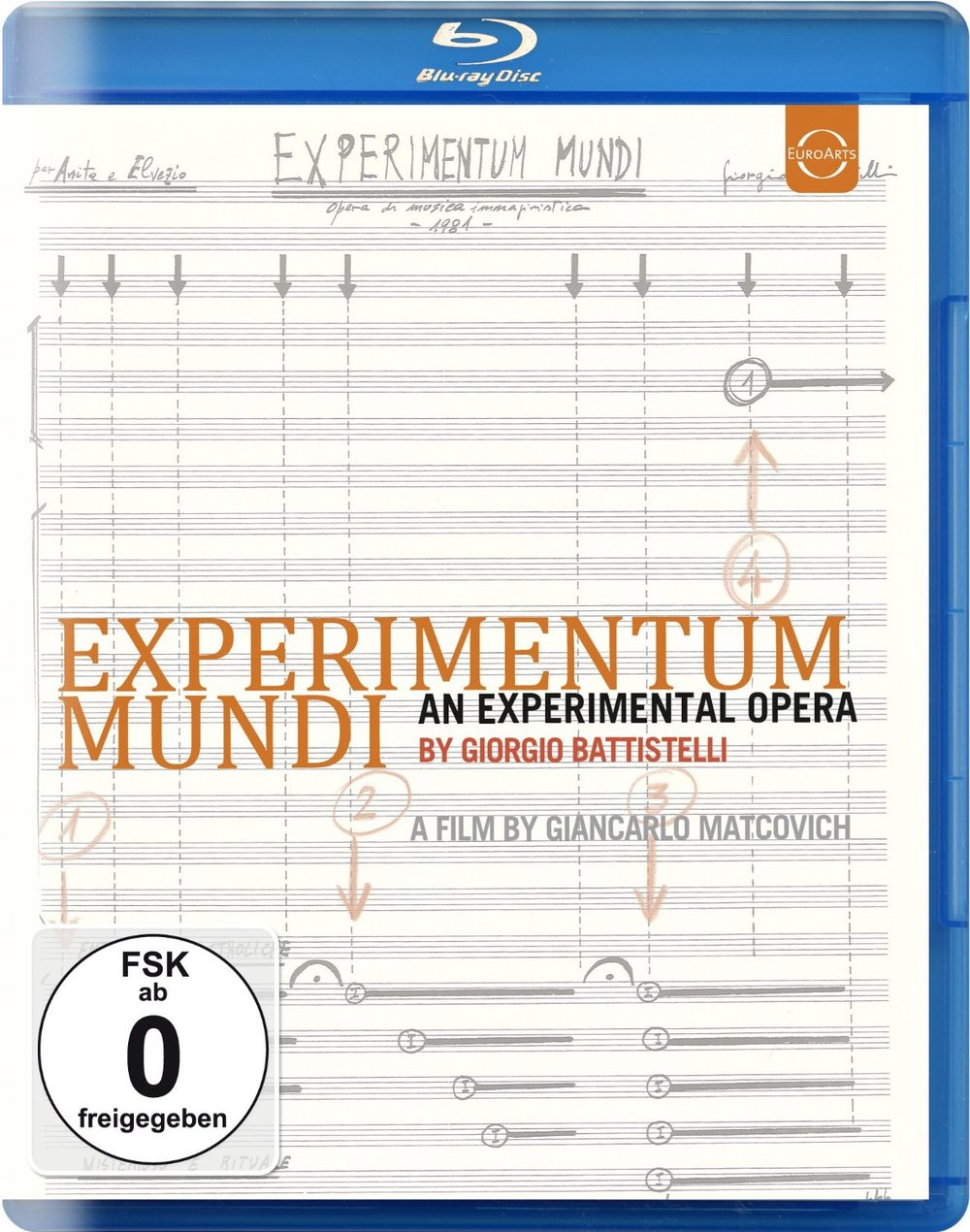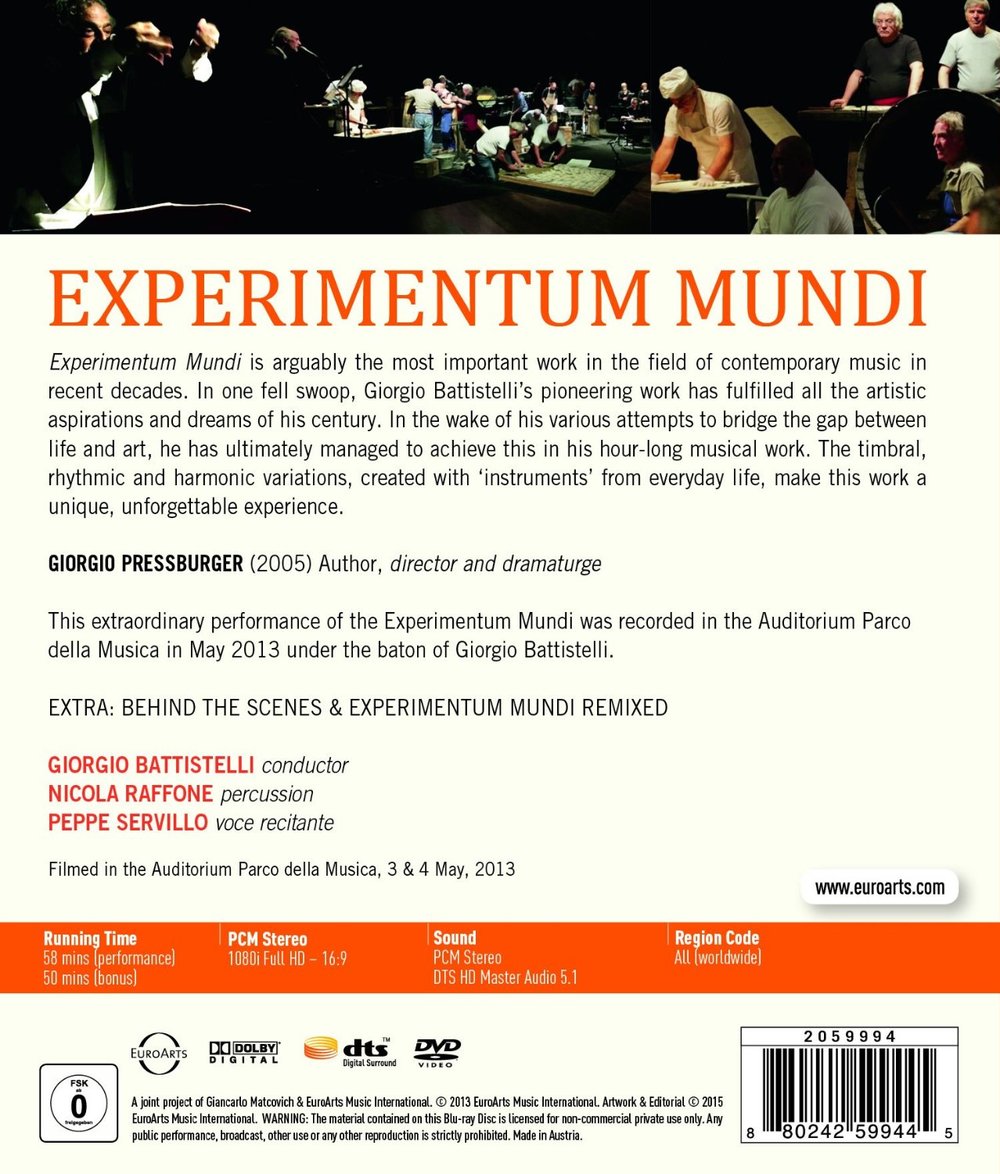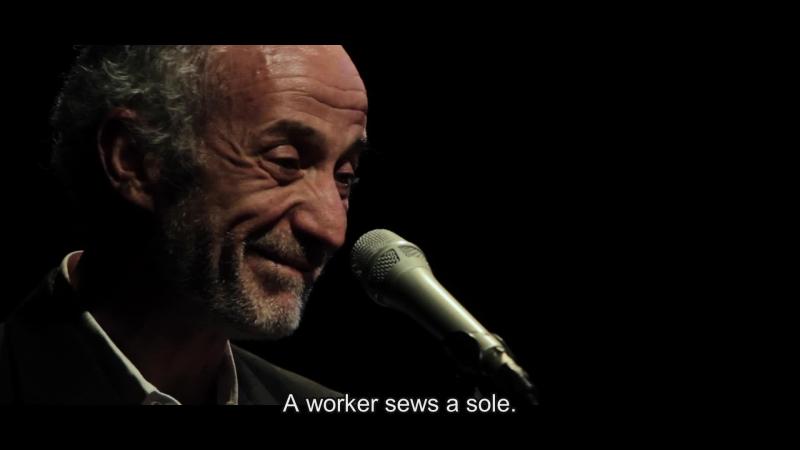

Giorgio Battistelli Experimentum Mundi opera (composed 1981). Staged and directed 2013 by the composer himself at the Auditorium Parco della Musica in Rome. Percussion by Nicola Raffone; voce recitante (both spoken and sung narration) by Peppe Servillo. Star performers and "accidental musicians" include male craftsmen and female citizens of Albano Laziale, a suburb of Rome. Directed for TV by Giancarlo Matcovich. The aspect ratio of the video is given as 16:9. But the film (while recorded at 30fps) is in "letterbox" format similar to the Cinemascope picture ratio of 1:2.35 that was used in Written on Skin. Released 2015, disc has 5.1 dts-HD Master Audio sound output.This is the only HDVD so far that has the score reprinted in the keepcase booklet (the front page of the score is also on the keepcase cover). But we know of no resource with the text of the libretto. Grade: A
The Latin title of this unique work, Experimentum Mundi, translates into English as "Experience of the World." Battistelli isn't speaking of experiencing the whole globe. To the contrary, what we experience here is a tiny and disappearing part of the world. The word "opera" means "works." So the term "experimental opera" refers both to Battistelli's composition and to the real-world crafts that are celebrated in the piece. Enough of theory for now. Let's jump right into screenshots.
Of the forces on stage, two persons are traditional classical musicians, and each of them wears white tie. Below is Battistelli, the composer and conductor. He was born in 1953 in Albano Laziale and started work on Experimentum Mundi at about age 20. After much trial and error, he finished the piece in 1981 when he was 28. It was his first opera, and he's written about 20 others since. I'm confident this was performed at night in the open-air arena that's part of the Auditorium Parco della Musica. There's no light except from small spots turned on from time to time as the piece progresses. This turns out to be extremely dramatic, but was doubtless a tough project for film-maker Matcovich:
The other white tie is on percussionist Nicola Raffone. He provides, of course, leadership in the performance and some melody with his drums (no keyboard instruments). He's the principal in a most unusual and much augmented percussion section:
Another driving force is the "voce recitante" or narrator Peppe Servillo, a self-taught singer, actor, and composer. He's a kind of bridge between the classical musicians and the worker-percussionists. So he gets to wear an open shirt and doesn't have to shave. He has a beautiful singing voice which he uses in a few bars. But mostly he adds tremendous personality to a somewhat quirky and obscure libretto:
The world that Battistelli wants us to experience is the world he knew as a child in his small town (then rather distant from Rome) as he wandered about watching and listening to all the craftsmen working at their trades. All the members of the augmented percussion section are men. Battistelli had to figure out a way to get a feminine touch into the mix. He also loved the sights and sounds of the ladies praying in church. He recruited four ladies (originally five) to provide a feminine background sound. The ladies voice names, prayers, and other repetitive text in a kind of murmur. You can't understand anything they say and there are no subtitles. Battistelli doesn't call the ladies "worshipers." He calls them "witches" or "fortune-tellers." The murmuring sound provides filler and a softening buffer for the cacophony that is conjured up by the men. The ladies from rear to near are Paola Calcagni, Anna Rita Severini, Elvira Battistelli, and Tiziana Delle Chiaie:
The piece opens with the odd sound of eggs dropping into a pool in the batter that the pastry-maker (Marcello Di Palma) will turn into pasta. Whipping and mixing sounds open up a rhythmic "singing line" for the entire opera to come. Originally, the narrated text was in French. Now it's in Italian. The translation of "Open waffle iron" maybe should have been, "Flat uncovered grill."
The narrator directs our attention to the next craft to be in the spotlight and to add new sounds: the cobblers or shoemakers:
The cobblers are Giovanni Piersanti and Guido Salustri. They make whirring sounds sharpening their tools and pounding noises as they work the leather over their lasts. (I should point out that all the craft activities in this work are performed manually — there are no power tools around.)
One of Battistelli's objectives as a composer was to break free of the chains in classical music that bind the orchestra to precise time-keeping and regular rhythms. Masons Ciro Paudice and Luigi Battistelli come in next with the sloppy, slushy, irregular sounds of mixing mortar. Later they will build a wall:
The soft mortar sounds give way to the staccato, spiky hammering of the toolmakers or blacksmiths (brothers Gianni Sannibale and Marco Sannibale):
Another solo craftsman is the lugubrious stonecutter Fernando Carpineti. He whacks away at his own speed making a stone pestle:
Next carpenters Alberto Casini and Silvio Tamburri provide various sounds from a woodworking project:
While all this is happening, the narrator gets increasingly ecstatic in an orgy of naming tools and craft techniques. In the next screenshot we see that the spotlights remain on the crafts that have been introduced. The newcomers in the foreground are the road builders Leonardo Innocenzi and Oberdan Carpineti with their sandbox and chopped stones:
A close-up shot of road builder Leonardo Innocenzi:
Now the coopers (barrel makers) Alfredo Sannibale and Fabio Sannibale show their skills and provide a deafening barrage of hammer blows on the iron barrel bands:
The tempo increases steadily as the sounds get ever louder. Finally, the grinders (also called swordsmiths or furbishers) come in played by Aldo Sardilli and Wladimiro Carpineti. They make a steady sound and also provide visual fireworks:
Below is the best shot in the video of the entire percussion section. At this point the pace is quickening fast for the finale:
Finally we get a good picture of Marcello Di Palma, the pastry-maker. He's cutting his roll into pasta strips while the narrator continues to go crazy over the names of tools and techniques:
Marcello sprinkles flower on the pasta to keep it from sticking together. I guess somebody will eat this the next day:
Everything is in uproar as Experimentum Mundi ends:
I think our screenshots show you that this is an interesting piece of modern music. I'll testify that the sound is more arresting than the video. But there is only a single CD of the music on the market. So I think this unique work needs both a good video and sound recording to be accessible to most music lovers. As presented here by Euroarts, it's a lively, interesting, and easily enjoyable modern work (that's also not too long).
One might question whether this is really classical music since it's unlikely (I think) that anyone other than Battistelli and his friends is likely to ever stage it. Perhaps it should be considered a work of performance art that's unique to one set of artists. Certainly it's one of the two most original works we have in HDVD (the other being Twin Spirits).
Experimentum Mundi is well-respected at least by reputation among modern music fans. But how many people have actually seen it? Based on what little I could read, I'll guess that Battistelli and his group have performed this, say, 300 times in the last 35 years. If 500 people came each time, then about 15,000 people would have seen it. Once Battistelli retires, the piece could become extinct.
Well, subject HDVD may well give Experimentum Mundi a longer life. It's possible this disc might become a collectors item. I'll be suggesting it to friends and relative who visit, which I don't do that often for contemporary music. So I'll give this an "A" grade.
OR

























